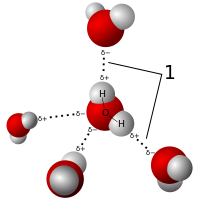
Photo from wikipedia
Abstract The research was aimed to determine the effects of extrusion process condition on the weld seam quality of the aluminum alloy AA6082 by using a novel physical simulation method.… Click to show full abstract
Abstract The research was aimed to determine the effects of extrusion process condition on the weld seam quality of the aluminum alloy AA6082 by using a novel physical simulation method. A weld seam between two bars was formed under hydrostatic pressure in a specially designed die setup to simulate the longitudinal weld seam formation during extrusion through porthole die. With this die setup, extrusion process variables, i.e., temperature, extrusion speed and strain, could be varied so that their individual effects on weld seam quality could be discriminated. With the help of finite element (FE) simulation, the distributions of strains, strain rates and hydrostatic pressures inside the welding chamber were quantified. Tension tests were performed to evaluate the bonding strengths of solid-state welded samples. It was found that the amount of deformation imposed inside the welding chamber had a dominant effect on the bonding strength. A high deformation temperature and a high extrusion speed enhanced the bonding strength. The microstructures across the weld zone were examined by using a polarized light microscope and electron back-scatter diffraction (EBSD). The microstructure evolutions inside and around the welding zone were found to be influenced by the deformation condition. High temperature, high extrusion speed and large deformation promoted the occurrence of local dynamic recrystallization, leading to reduced mean grain sizes inside the welding zone, corresponding to an enhanced strength at the weld seam.
Journal Title: Journal of Materials Processing Technology
Year Published: 2017
Link to full text (if available)
Share on Social Media: Sign Up to like & get
recommendations!